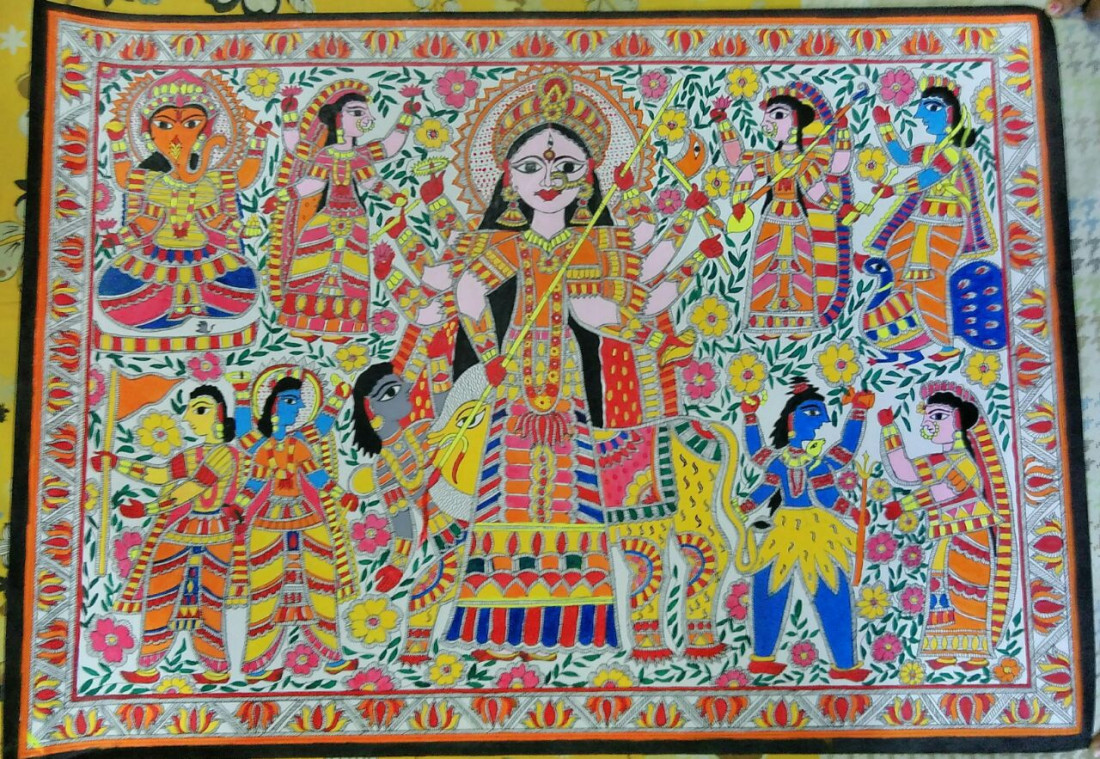[This piece of article is provided by Ms. SONAM DHINGRA who is a prominent art teacher at City Vocational Public School, Meerut, by profession and an artist herself. She has done in-depth research on indian arts and crafts.]
While on the one hand, the large-scale demand and high prices of the artworks by Madhubani women reflects the empowerment of women and recognition of both the village art and women at the global level, on the other hand, there is a paradox as the commercialization of the art came only through the sahukar (middleman), who symbolizes the financial exploitation of the artists. The sahukar becomes the major profit-maker while the artists get meagre returns for their work. The persistent lack of rainfall and sole dependence of the local families on the income generated from the paintings over the last couple of decades have also increased poverty in this region.
The existence of a high degree of codification and stratification of caste in the region has exacerbated the problems of the artists and intensifies the informal nature of the industry. Caste also plays an important role in the selection and distribution of paintings for sale. The sahukar belongs to an upper caste; he selects only the paintings made by upper caste women for sale, and even if he does select any paintings made by women of lower castes, he gives them lesser returns even if they fetch a better market price. In addition, women belonging to the upper or forward castes get more opportunities than their counterparts from the lower castes, of exhibiting their work at global forums and international fairs. The market value of the paintings made by the artists from this village in the global market is high.
However, the rate of return accruing to an artist depends on whether she is a contract artist or an independent artist. The price of painting paid to a contract artist is determined on a piece rate basis, whereas an independent artist gets paid according to the size and content of the painting, with the price ranging.
Despite all the constraints and stratification in the industry, Madhubani paintings have created a new kind of image of the women members of the local communities.
The commercialisation has caused serious harm to this art. The women and men are learning this art from the markets in towns and cities. The trainers themselves do not know the essence and aesthetic beauty of this art and teach their students in utter ignorance. Some of them do not know the colour combinations, how to obtain the colours from nature, preparing the background, the relationship between rhythm, colour, songs, rituals, dance and painting.
The themes and designs of the paintings are now, in most cases, decided by the buyers. The buyer-centric approach is a serious threat to the originality of colour, design, motif, and sensitivity of this art form. Commercialisation of this art has attracted several males also. For them, it is an industry that can easily provide a job opportunity. They are willing to paint anything for buyers in the name of Mithila painting.
In Mithila Paintings as folk paintings painted on ritual occasions or as ritual paintings of India, we find a combination of many activities. This combination, in fact, gives a special significance to the art.
Seeing the financial prosperity of women, some men have also begun to make these paintings for commercial purpose. In such cases, the conventional patriarchal mode gets established where the man earns through these paintings and the woman is dependent on him. Now she has forsaken the ritual domestic space and the access to the modern professional space is denied to her. In cases where she is the major breadwinner of the family, she does command a lot of power in financial matters and this is where the state has been successful. However, the research is required to see whether such
a woman in just a source of income to her family or whether she is the decision maker too, for without this power, just the economic strength does not really empower a woman.
Male scholars, both Indian and western, have been major interpreters of Madhubani Painting. The conservativeness of the Mithila society and the segregation of women made it unlikely that women could take an active part in the interpretation of their art. The educated men of their community took over the task of mediating it to the outsiders. As Mithila society urbanizes and globalizes, art history is equipping itself slowly with methodologies that can embrace the complex contemporary of art forms are doubly misunderstood because of their folk and gendered status.



